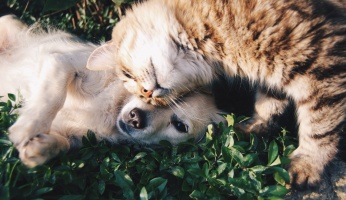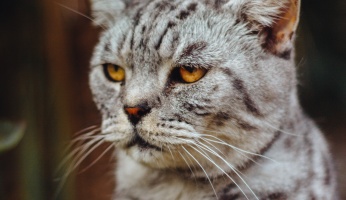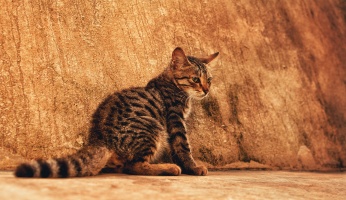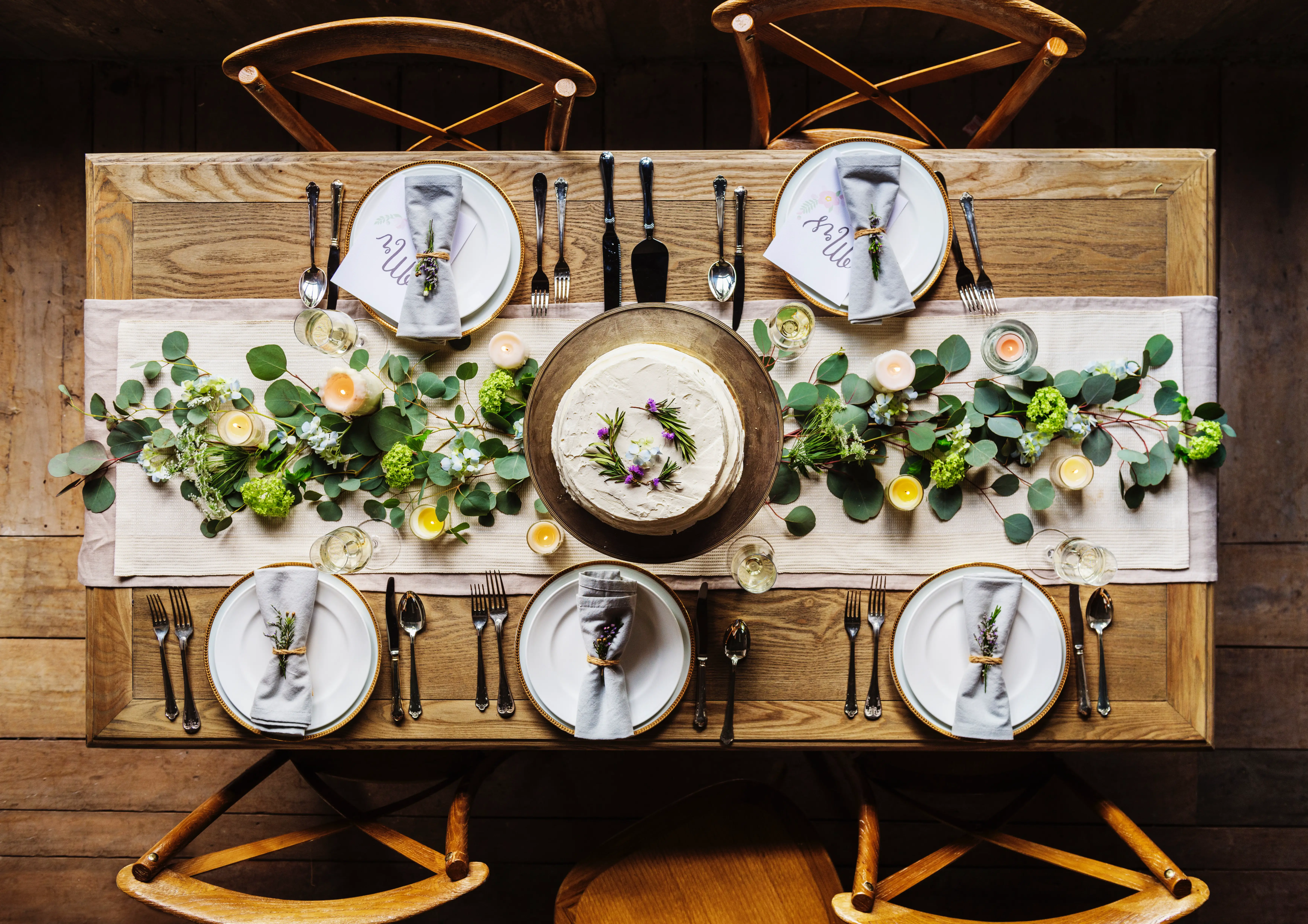18 Saltwater Aquarium Fish for Beginners
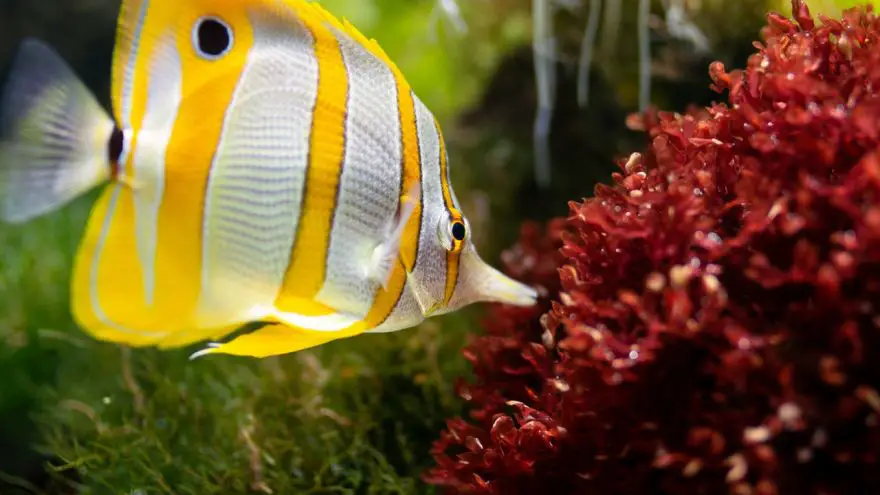 18 Saltwater Aquarium Fish for Beginners
thegearhunt.com
18 Saltwater Aquarium Fish for Beginners
thegearhunt.com
Owning a saltwater aquarium that is thriving is the dream of quite a few aquarists.
Keeping freshwater fish can be both rewarding and fun, but there is just something special about saltwater fish and their exotic beauty. These are fish that are capable of capturing our hearts – from the clownfish we adored in Finding Nemo to the unique seahorse, there is something that is sure to interest any fish keeper.
To that end, we have put together this guide to saltwater fish and have divided them into categories according to how easy or difficult it is to care for them. Hopefully, this will make it easier for you to choose the ones that will be best for your aquarium.
Beginner Saltwater Fish
Ocellaris Clownfish
 This particular clownfish is the most popular and common in the family of clownfish. This is likely due to their being easy to take care of and peaceful. They are also easily recognizable from Finding Nemo. They are ideal for beginners and a fantastic fish to begin your saltwater aquarium with.
This particular clownfish is the most popular and common in the family of clownfish. This is likely due to their being easy to take care of and peaceful. They are also easily recognizable from Finding Nemo. They are ideal for beginners and a fantastic fish to begin your saltwater aquarium with.
This clownfish can grow to a size of 4 inches and can live for as long as 6 years. They lay eggs and are quite easy to breed. You can find them naturally in the Asian Pacific region and they will thrive in a water temperature of about 75 F that has a pH of between 8 and 8.4. You can feed the clownfish frozen food, meat, fish food pellets or flakes. The recommended minimum tank size for them is 30 gallons.
This fish is a funny swimmer and peaceful and they might accept host anemones. They are best kept in a tank with other species of fish, but they might be aggressive if kept with other clownfish.
Royal Gramma
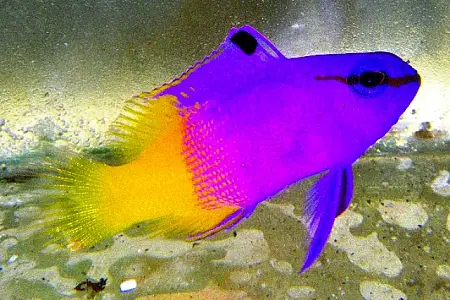 The Royal Gramma basslet is another breed of colorful and popular saltwater fish that will be a hit in any aquarium. They are friendly for beginners due to their being easy to care for, peaceful, and small. They are also called the fairy basslet because of their incredible colors.
The Royal Gramma basslet is another breed of colorful and popular saltwater fish that will be a hit in any aquarium. They are friendly for beginners due to their being easy to care for, peaceful, and small. They are also called the fairy basslet because of their incredible colors.
This fish can grow to as long as 3 inches and can live as long as 5 years. They lay eggs and tend to breed easily. They are found naturally in the Caribbean and will thrive in water that has a temperature of around 76 F and a pH between 8 and 8.4. You can feed them frozen foods, meat, pellets, or flakes. The minimum recommended tank size is 30 gallons.
The Royal Gramma is typically peaceful but has been known to be territorial – especially towards fish that are smaller. They can be kept either alone or in pairs and do well in community aquariums.
Black Cap Basslet
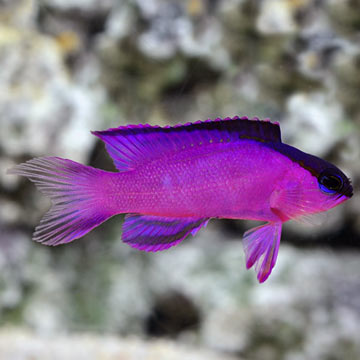 This basslet is a bit more unusual than the one we just discussed. That said, it is just as good for a beginner’s saltwater aquarium. They might be a touch more aggressive towards invertebrates that are quite small.
This basslet is a bit more unusual than the one we just discussed. That said, it is just as good for a beginner’s saltwater aquarium. They might be a touch more aggressive towards invertebrates that are quite small.
This basslet will grow to be about 4 inches long and can live for as long as 4 years. They lay eggs and will guard them. You can find them naturally in the Caribbean and they thrive in water that has a temperature of about 76 F and a pH of between 8.1 and 8.4. You can feed them meaty food and pellets and they need a minimum tank size of 30 gallons with a lot of live rock.
This basslet is peaceful but has been known to be aggressive around other basslets and territorial towards invertebrates that are smaller. You can either keep them by themselves or with other fish of the same size.
Snowflake Eel
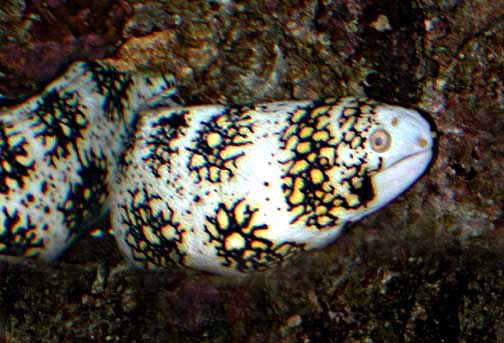 The Snowflake eel has an alias – the Snowflake Moray Eel. When it comes to eels that are kept in saltwater aquariums, this one is the most common one due to its docile personality and the ease of care. That said, they are known to escape, so you should always ensure the aquarium they are in has a tight-fitting lid.
The Snowflake eel has an alias – the Snowflake Moray Eel. When it comes to eels that are kept in saltwater aquariums, this one is the most common one due to its docile personality and the ease of care. That said, they are known to escape, so you should always ensure the aquarium they are in has a tight-fitting lid.
This eel can grow to a length of 28 inches and can live as long as 4 years. They lay eggs, but it is difficult to get them to breed. They can be found in nature in the Pacific, East Africa, and Central America. They thrive in water that has a temperature of about 75 F and a pH between 8.1 and 8.4. You can feed them both live food and meaty food. The minimum recommended tank size for this eel is 75 gallons. It should be equipped with cave areas, live rock, and a secure hood. This eel has a docile personality and will mostly be active at night. They are best kept with no other eels, but can be put with both large, aggressive fish and with invertebrates, but no crustaceans.
Yellow Striped Cardinalfish
 This is a small, colorful, and peaceful saltwater fish. It is a species that is quite popular with beginner saltwater aquarists. It has a tendency to be a bit shy, so it will be best if you provide it with hiding areas such as sea grass.
This is a small, colorful, and peaceful saltwater fish. It is a species that is quite popular with beginner saltwater aquarists. It has a tendency to be a bit shy, so it will be best if you provide it with hiding areas such as sea grass.
This cardinalfish can grow to be 2.5 inches in length. Although the female lays eggs, they can be difficult to breed. They can be found in nature in the Asian Pacific and will thrive in water that has a temperature of about 75 F and a pH of between 8.1 and 8.4. You can feed them meaty food, pellets, or live food. The recommended minimum tank size for this fish is 10 gallons. This is a peaceful fish and will be best kept in small groups or pairs and with tankmates that are also peaceful.
Dotty Backs
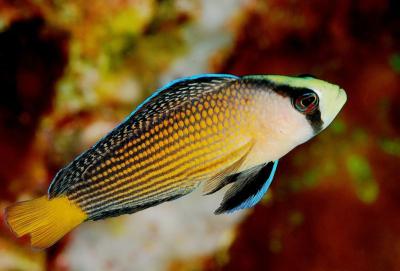 There is quite a variety of this fish available. If you are looking for a vibrant variety, try the Bicolor or Purple Dotty Back. While this species can be a bit aggressive when kept in smaller tanks, they are still a good option for the beginner who is committed.
There is quite a variety of this fish available. If you are looking for a vibrant variety, try the Bicolor or Purple Dotty Back. While this species can be a bit aggressive when kept in smaller tanks, they are still a good option for the beginner who is committed.
The Dotty Back can grow to be as long as 3 inches and can live as long as 7 years. They can be found in nature in Southeast Asia and will thrive in water that is about 75 F and has a pH between 8.1 and 8.4. You can feed them meaty food. The minimum suggested tank size is 30 gallons and it should be equipped with live rock and hiding places. In smaller tanks, they can be aggressive and are quite capable of holding their own against fish that are larger. They are kept best with larger fish that are semi-aggressive.
Neon Blue Goby
 When it comes to the Goby, there are more than 200 species. They are quite popular for many saltwater aquariums. The one that seems to be the most common is the Neon Blue variety. Gobies tend to be pretty peaceful and will even provide a sort of parasitic cleaning service for any larger reef fish that might share a tank with them.
When it comes to the Goby, there are more than 200 species. They are quite popular for many saltwater aquariums. The one that seems to be the most common is the Neon Blue variety. Gobies tend to be pretty peaceful and will even provide a sort of parasitic cleaning service for any larger reef fish that might share a tank with them.
This Goby can grow to a length of about 2 inches and lay eggs. They will spawn in crevices. You can find them in nature in the Caribbean and they enjoy water that is about 75 F with a pH of between 8.1 and 8.4. You can feed them meaty, frozen, or live foods. They will do best with a minimum tank size of 10 gallons. The Goby is a peaceful fish, although they can show aggression to other Gobies they aren’t in a mated pair with. They are best kept in that single mated pair or by themselves in an aquarium with a Nano-reef.
Yellow Tail Damselfish
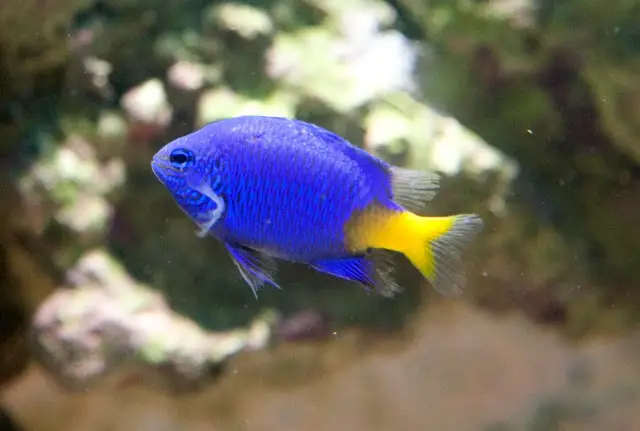 This family of fish are best known for the deep blue color of them and they are quite popular with saltwater aquarists. This particular variety is so named because along with the beautiful blue color, they feature a yellow tail. They also tend to be a bit less aggressive than other fish in this family and because of this are better suited for beginners.
This family of fish are best known for the deep blue color of them and they are quite popular with saltwater aquarists. This particular variety is so named because along with the beautiful blue color, they feature a yellow tail. They also tend to be a bit less aggressive than other fish in this family and because of this are better suited for beginners.
This Damselfish typically grows to a length of 3 inches and can live for as long as 15 years. They lay eggs when they breed, and the male will aggressively guard them. You can find them in nature in the Indo-Pacific region. They thrive in water that has a temperature of about 75 F and a pH between 8.1 and 8.4. You can feed them meaty food and they are best kept in an aquarium that is at least 30 gallons and has places for them to hide. The Damselfish is typically peaceful, but they might act a bit territorial to others of the same size or species.
Intermediate Fish
Blennies
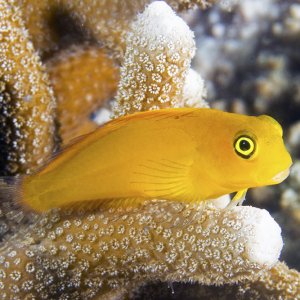 These fish look a lot like gobies. Also like the Goby, a Blenny is a great addition to any saltwater aquarium. There are quite a few variations to choose from too. Because they tend to be territorial, they are recommended for intermediate aquarists who are looking for a bit more challenge.
These fish look a lot like gobies. Also like the Goby, a Blenny is a great addition to any saltwater aquarium. There are quite a few variations to choose from too. Because they tend to be territorial, they are recommended for intermediate aquarists who are looking for a bit more challenge.
The blennies can grow to a length of 4 inches and can live as long as 4 years. Although they lay eggs, it can be difficult to get them to breed. They are found in nature in the Indo-Pacific region and prefer water that is about 75 F with a pH of between 8.1 and 8.4. You can feed them dried food, frozen food, and live food. The smallest recommended tank size for them is 30 gallons and the aquarium should feature a few places for them to hide. This is typically a peaceful fish, but they can be both reclusive and territorial to other Blennies. It is best to keep them as the only one of its species in a community aquarium.
Picasso Triggerfish
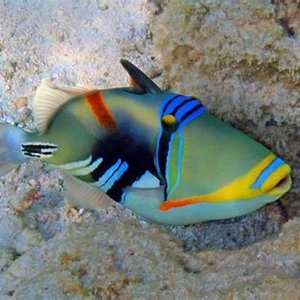 The Triggerfish is certainly unique looking. They’re also known for the ability to rotate each eyeball individually. There are about 40 variations of this fish. Because they can have a bit of a temper, they are recommended for intermediate aquarists. Other than the temper, they tend to be easy to care for and are quite hardy.
The Triggerfish is certainly unique looking. They’re also known for the ability to rotate each eyeball individually. There are about 40 variations of this fish. Because they can have a bit of a temper, they are recommended for intermediate aquarists. Other than the temper, they tend to be easy to care for and are quite hardy.
The Triggerfish can grow to a length of 10 inches and can live as long as 10 years. Although they lay eggs, it is difficult to get them to breed. They can be found in nature in the Indo-Pacific region and do well in water that is about 75 F with a pH of between 8.1 and 8.4. You can feed them hard-shelled crustaceans, meaty food, frozen food, and live food. The smallest recommended tank size for them is 180 gallons and it should be equipped with rocks and caves. In small tanks, they are clumsy. They can be quite territorial and aggressive. It is best to keep them in a tank that has larger aggressive fish and one that doesn’t have a reef.
Grouper
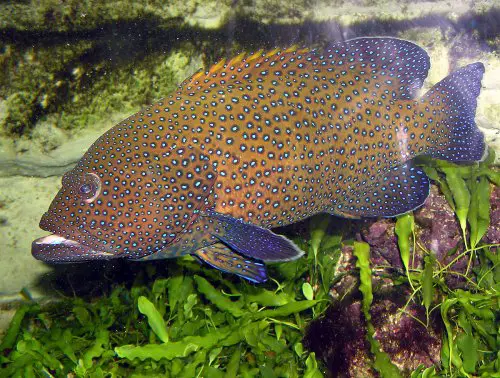 This is a popular option for saltwater aquariums. They can be a bit aggressive, so an aquarist with a bit of experience is best. Groupers are known for their stout, large bodies and mouths that sort of droop. They do require quite a bit of space if you want them to thrive because they produce a LOT of waste and prefer open swimming.
This is a popular option for saltwater aquariums. They can be a bit aggressive, so an aquarist with a bit of experience is best. Groupers are known for their stout, large bodies and mouths that sort of droop. They do require quite a bit of space if you want them to thrive because they produce a LOT of waste and prefer open swimming.
The Grouper can grow to a length of 12 inches and can live as long as 30 years. Although they lay eggs, it is difficult to get them to breed. They can be found in nature in the Indo-Pacific region and do well in water that is about 75 F with a pH of between 8.1 and 8.4. You can feed them meaty food, frozen food, and live food. The smallest recommended tank size for them is 200 gallons and it should be equipped with rocks and caves. They can be quite predatory and aggressive, especially when it comes to crustaceans and smaller fish. It is best to keep them in a tank that has larger aggressive fish and other groupers.
Longnose Batfish
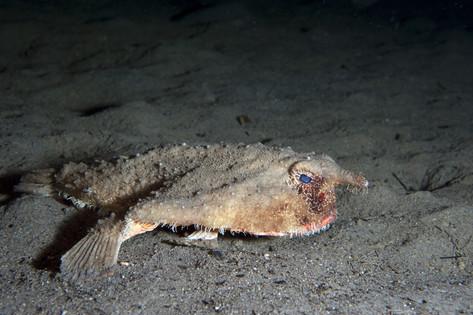 This is a saltwater fish that looks interesting and ‘walks’. It will spend the majority of its time near the bottom of the aquarium. This fish is typically pretty peaceful, but it has care needs that are a bit more complex and because of this, it is categorized as an intermediate fish.
This is a saltwater fish that looks interesting and ‘walks’. It will spend the majority of its time near the bottom of the aquarium. This fish is typically pretty peaceful, but it has care needs that are a bit more complex and because of this, it is categorized as an intermediate fish.
The Longnose Batfish can grow to a length of 10 inches. They can be found in nature in the Caribbean and do well in water that is about 75 F with a pH of between 8.1 and 8.4. You can feed them live food, but it might be difficult to get them to eat when they are in captivity. The smallest recommended tank size for them is 75 gallons and it should be equipped with gravel substrate or sand and lighting that is dim. They are docile and slow moving. It is best to keep them in a tank that has other slow moving and docile fish.
Tangs
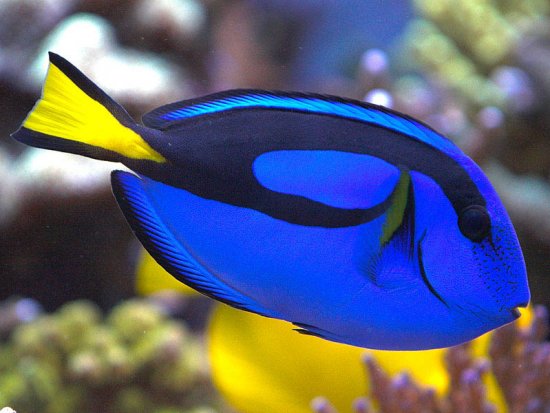 We already saw Nemo, now here is Dory! The Blue Tang is best for fish keepers with a bit more experience because of the fact that they need a lot of room and in certain circumstances can be aggressive.
We already saw Nemo, now here is Dory! The Blue Tang is best for fish keepers with a bit more experience because of the fact that they need a lot of room and in certain circumstances can be aggressive.
The Tang can grow to a length of 12 inches and can live as long as 5 years. Although they lay eggs, it is difficult to get them to breed. They can be found in nature in the Indo-Pacific region and do well in water that is about 77 F with a pH of between 8.1 and 8.4. You can feed them meaty food, live food, vegetables, and algae. The smallest recommended tank size for them is 180 gallons and it should be equipped with rocks and have a good flow of water. They can be quite peaceful except when kept with other Tangs. It is best to keep them in a tank with other fish.
Elite Saltwater Fish
Cleaner Wrasses
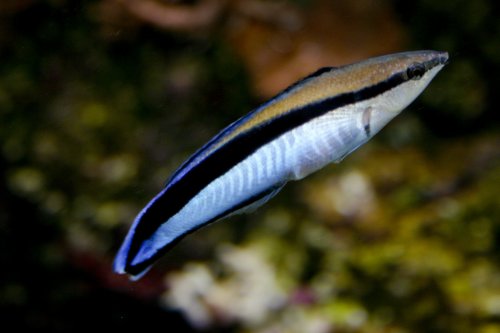 Keeping one of these fish alive and making sure they thrive in your aquarium is quite difficult. Because they won’t necessarily take other food than what they are able to clean off of the other fish in the tank with them, they are likely to starve.
Keeping one of these fish alive and making sure they thrive in your aquarium is quite difficult. Because they won’t necessarily take other food than what they are able to clean off of the other fish in the tank with them, they are likely to starve.
The Cleaner Wrasse can grow to a length of 5 inches. They can be found in nature in the Indo-Pacific region and do well in water that is about 75 F with a pH of between 8.1 and 8.4. You can feed them meaty, fresh food, and parasites. The smallest recommended tank size for them is 70 gallons and it should be equipped with rocks and caves. They can be quite peaceful and will even set up cleaning stations for tank mates so that they can remove any unwanted parasites from them. It is best to keep them in a tank that has tank mates of various sizes, are colorful, and have been researched thoroughly.
Lionfish
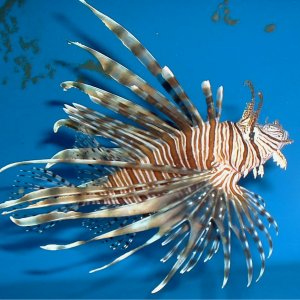 Lionfish are known for their spines that are venomous and for being predatory. This means that they should only be in an experienced aquarist’s collection. It isn’t likely that their venom can be fatal to healthy adults, but those who are allergic and small children should be kept away from them. There are quite a few variations of this fish, including a dwarf one, but the following is general information.
Lionfish are known for their spines that are venomous and for being predatory. This means that they should only be in an experienced aquarist’s collection. It isn’t likely that their venom can be fatal to healthy adults, but those who are allergic and small children should be kept away from them. There are quite a few variations of this fish, including a dwarf one, but the following is general information.
The Lionfish can grow to a length of 15 inches and can live as long as 15 years. Although they lay eggs, it is difficult to get them to breed. They can be found in nature in the Indo-Pacific region and do well in water that is about 75 F with a pH of between 8.1 and 8.4. You can feed them meaty food and live food. The smallest recommended tank size for them is 120 gallons and it should be equipped with rocks and caves. They can be quite territorial and aggressive. It is best to keep them in a tank that has larger aggressive fish.
Spiny Box Puffer
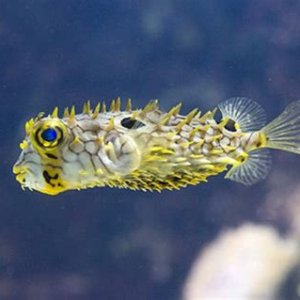 Having a saltwater puffer is a goal for quite a few aquarists, and this one specifically is thought to be the Holy Grail. It requires a lot of room for swimming, so you need to ensure that you’re able to buy an aquarium that is large enough for it.
Having a saltwater puffer is a goal for quite a few aquarists, and this one specifically is thought to be the Holy Grail. It requires a lot of room for swimming, so you need to ensure that you’re able to buy an aquarium that is large enough for it.
This fish can grow to a length of 10 inches. You can find it in nature in the Caribbean and it will thrive in water that is about 75 F and that has a pH of between 8.1 and 8.4. They do require a higher quality of water. You can feed them shellfish and a variety of meaty food, but they can be slow when it comes to adapting. The recommended minimum tank size is 180 gallons and it should only have fish in it. When it comes to long-finned or slow-moving fish, they can be a bit nippy, but they aren’t aggressive when put with other puffers.
Cat Shark
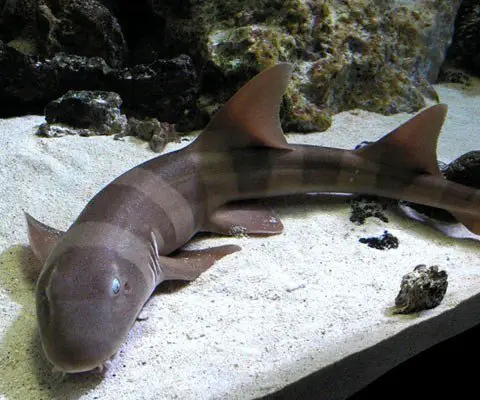 When you want to add one of these to your collection, you need to make sure that you have a LOT of experience with saltwater fish first. Cat sharks can get quite large, are aggressive, and need a lot of space.
When you want to add one of these to your collection, you need to make sure that you have a LOT of experience with saltwater fish first. Cat sharks can get quite large, are aggressive, and need a lot of space.
This fish can grow to a length of 3 feet. You can find it in nature in Southeast Asia and it thrives in water that has a temperature of about 77 F and a pH of between 8.1 and 8.4. You can feed them meaty or live foods, but they can be quite finicky. The minimum recommended tank size is 360 gallons and it should have sand substrate. This is a rather slow swimming fish that will eat invertebrates and be aggressive in general. They should be kept with no other cat sharks and not in a reef tank. They also won’t do well with other fish that prefer the bottom or those that will nip their fins.
Sea Horse
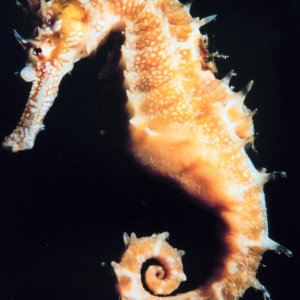 This one seems to be the dream of every saltwater aquarist! They are unique and beautiful and work best for those aquarists who are content with only this species and possibly a pipefish or two in the tank. Kuda is the easiest to care for and most common of the species.
This one seems to be the dream of every saltwater aquarist! They are unique and beautiful and work best for those aquarists who are content with only this species and possibly a pipefish or two in the tank. Kuda is the easiest to care for and most common of the species.
This fish can grow to a length of 6 inches and can live as long as 4 years. They lay eggs and will breed when in mated pairs, but the young are difficult to raise. You can find it in nature in the Asian Pacific region and it thrives in water that has a temperature of about 73 F and a pH of between 8.1 and 8.4. You can feed them frozen or enriched foods. The minimum recommended tank size is 30 gallons and it should have a lot of live rock and places to hide. This is a rather poor swimmer that is both peaceful and shy.
And that’s it! Our guide to the best saltwater fish for your aquarium. Which is next on your list?
Sources
- You Tube, Top 10 Saltwater Fish for Beginners
- Aquarium Creations Online, Marine Aquarium Fish for Beginners
- The Spruce Pets, Awesome Beginner Fish for a Saltwater Aquarium
- LiveAquaria, Marine Fish for Beginners





